The NVIDIA GeForce RTX 2080 Ti & RTX 2080 Founders Edition Review: Foundations For A Ray Traced Future
by Nate Oh on September 19, 2018 5:15 PM EST- Posted in
- GPUs
- Raytrace
- GeForce
- NVIDIA
- DirectX Raytracing
- Turing
- GeForce RTX
Power, Temperature, and Noise
With a large chip, more transistors, and more frames, questions always pivot to the efficiency of the card, and how well it sits with the overall power consumption, thermal limits of the default ‘coolers’, and the local noise of the fans when at load. Users buying these cards are going to be expected to push some pixels, which will have knock on effects inside a case. For our testing, we use a case for the best real-world results in these metrics.
Power
All of our graphics cards pivot around the 83-86W level when idle, though it is noticeable that they are in sets: the 2080 is below the 1080, the 2080 Ti sits above the 1080 Ti, and the Vega 64 consumes the most.
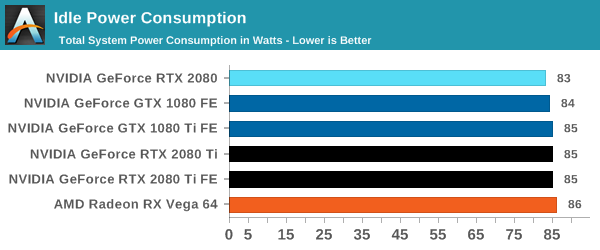
When we crank up a real-world title, all the RTX 20-series cards are pushing more power. The 2080 consumes 10W over the previous generation flagship, the 1080 Ti, and the new 2080 Ti flagship goes for another 50W system power beyond this. Still not as much as the Vega 64, however.
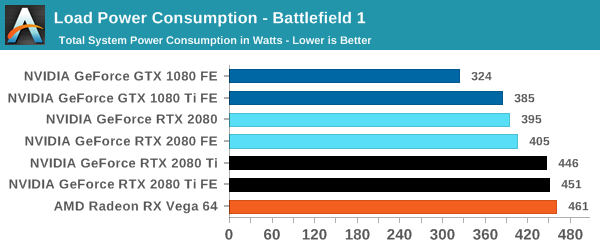
For a synthetic like Furmark, the RTX 2080 results show that it consumes less than the GTX 1080 Ti, although the GTX 1080 is some 50W less. The margin between the RTX 2080 FE and RTX 2080 Ti FE is some 40W, which is indicative of the official TDP differences. At the top end, the RTX 2080 Ti FE and RX Vega 64 are consuming equal power, however the RTX 2080 Ti FE is pushing through more work.
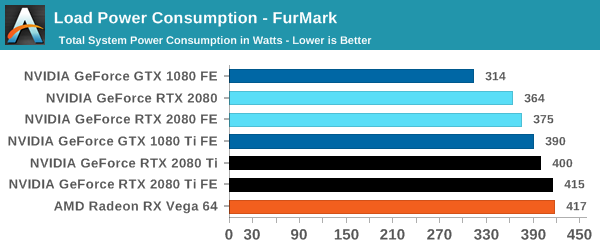
For power, the overall differences are quite clear: the RTX 2080 Ti is a step up above the RTX 2080, however the RTX 2080 shows that it is similar to the previous generation 1080/1080 Ti.
Temperature
Straight off the bat, moving from the blower cooler to the dual fan coolers, we see that the RTX 2080 holds its temperature a lot better than the previous generation GTX 1080 and GTX 1080 Ti.
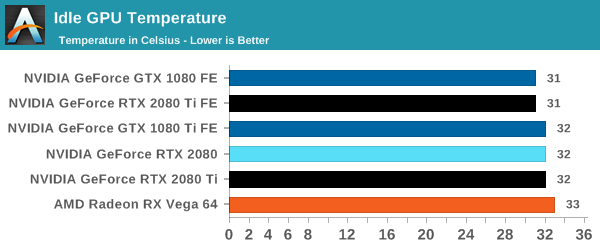
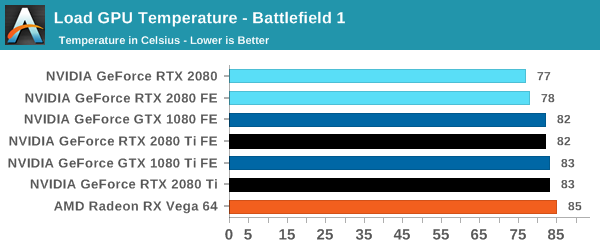
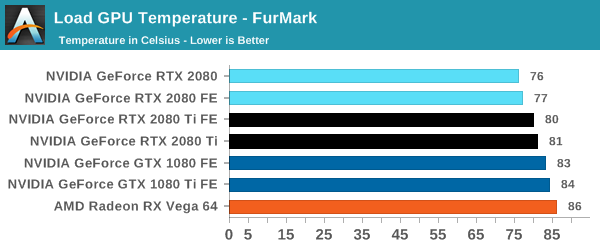
At each circumstance at load, the RTX 2080 is several degrees cooler than both the previous generation and the RTX 2080 Ti. The 2080 Ti fairs well in Furmark, coming in at a lower temperature than the 10-series, but trades blows in Battlefield. This is a win for the dual fan cooler, rather than the blower.
Noise
Similar to the temperature, the noise profile of the two larger fans rather than a single blower means that the new RTX cards can be quieter than the previous generation: the RTX 2080 wins here, showing that it can be 3-5 dB(A) lower than the 10-series and perform similar. The added power needed for the RTX 2080 Ti means that it is still competing against the GTX 1080, but it always beats the GTX 1080 Ti by comparison.
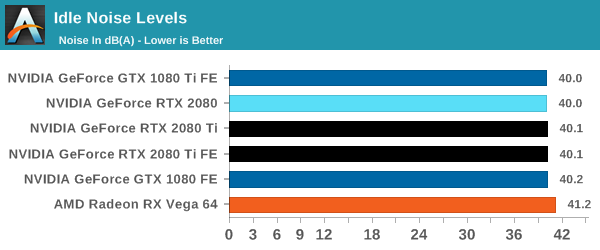
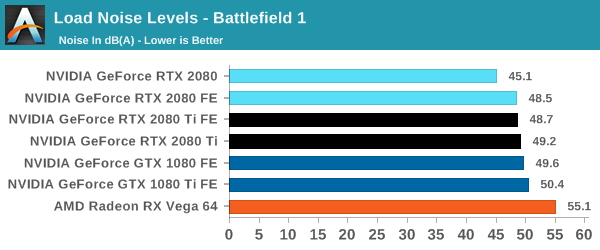
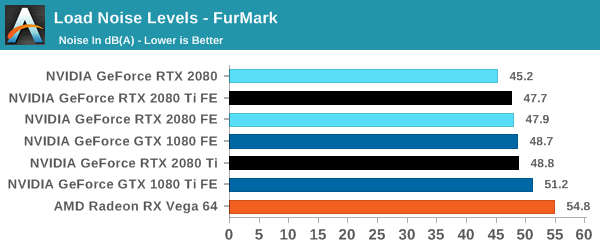










337 Comments
View All Comments
Dribble - Thursday, September 20, 2018 - link
The DLSS basically gives you a resolution jump for free (e.g. 4k for 1440p performance) and is really easy to implement. That's going to take off fast and probably means even the 2070 will be faster then the 1080Ti in games that support it.Lolimaster - Saturday, September 22, 2018 - link
No not free, everyone can see the blurry mess the renamed blur effect is.Inteli - Saturday, September 22, 2018 - link
TIL that when you stop isolating variables in a benchmark, a lower-end card can be faster than a higher-end card.tamalero - Wednesday, September 19, 2018 - link
Die size is irrelevant to consumers. They see price vs performance. not how big the silicon is.AMD was toasted for having hot slow chips. many times.. so did nvidia.. big and hot means nothing if it doesn't perform as expected for the insane prices they 're asking for.
Yojimbo - Wednesday, September 19, 2018 - link
Die size is not irrelevant to consumers because increased die size means increased cost to manufacture. Increased cost to manufacture means a pressure for higher prices. The question is what you get in return for those higher prices.People like what they know... what they are used to. If some new AA technique comes along and increases performance significantly but introduces visual artifacts it will be rejected as a step backwards. But if a new technology comes along that has a significant performance cost yet increases visual quality much more significantly than the aforementioned artifacts decrease it, people will also have a tendency to reject it. That is, until they become familiar with the technology... That's where we are with RTX. No one can become familiar with the technology when there are no games that make use of it. So trying to judge the value of the larger die sizes is an abstract thing. In a few months the situation will be different.
Personally, I think the architecture will be remembered as one of the biggest and most important in the entire history of gaming. There is so much new technology in it that some of it barely anyone is saying much about (where have you heard about texture space shading, for example?). Several of these technologies will have their greatest benefits with VR, and if VR had taken off people would be marveling about this architecture immediately. But I think that VR will eventually take off, and I think several of these technologies will become the standard way of doing things for the next several years. They are new and complicated for developers, though. Only a few developers are prepared to take advantage of the stuff today. It's going to be some time before we really can put the architecture into its proper historical perspective.
From the point of view of a purchase today, though, it's a bit of an unknown. If you buy a card now and plan to keep it for 4 years, I think you'd be better off getting a 20 series than a 10 series. If you buy it and keep it for 2 years, then it's a bit less clear, but we'll have a better idea of the answer to that question in 6 months, I think.
I do think, though, that if an architecture with this much new stuff were introduced 20 years ago everybody, including games enthusiast sites like Anandtech, would be going gaga over it. The industry was moving faster then and people were more optimistic. Also the sites didn't try to be so demure. Hmm, gaga as the opposite of demure. Maybe that's why she's called Lady Gaga.
Santoval - Wednesday, September 19, 2018 - link
I agree that this might be the most game-changing graphics tech of the last couple of decades, and that the future belongs to ray-tracing, but I also think that precisely due to the general uncertainty and the very high prices Nvidia might suffer one of their biggest sales slumps this generation, if not *the* biggest. They did not handle the launch well : it is absurd to release a new series with zero ray-traced, DLSS supporting or mesh shaded games at launch.Their extensive NDAs, lack of information and ban on benchmarks between the Gamescom pre-launch and the actual launch, despite going live with (blind faith based) preorders during that window, was also controversial and highly suspicious. It appears that Nvidia gave graphics cards to game developers very late to avoid leaks, but that resulted in having no RTX supporting games at launch. They thought they could not have it both ways apparently, but choosing that over having RTX supporting games at launch was a very risky gamble.
Since their sales will almost certainly slump, they should release 7nm based graphics cards (either a true 30xx series or Turing at 7nm, I guess the latter) much sooner, probably in around 6 months. They might have expected a sales slump, which is why they released 2080Ti now. I suppose they will try to avoid it with aggressive marketing and somewhat lower prices lately, but it is not certain they'll succeed.
eddman - Thursday, September 20, 2018 - link
Would you've still defended this if it was priced at $1500? How about $2000? Do you always ignore price when new tech is involved?The cards, themselves, aren't bad. They are actually very good. It's their pricing.
These cards, specifically 2080 Ti, are overpriced compared to their direct predecessors. Ray tracing, DLSS, etc. etc. they still do not justify such prices for such FPS gains in regular rasterized games.
A 2080 Ti might be an ok purchase for $850-900, but certainly not $1200+. Even 8800 GTX with its new cuda cores and new generation of lighting tech launched at the same MSRP as 7800 GTX.
These cards are surely more expensive to make, but there is no doubt that the biggest factor for these price jumps is that nvidia is basically competing with themselves. Why price them lower when they can easily sell truckloads of pascal cards at their usual prices until the inventory is gone.
Andrew LB - Thursday, September 20, 2018 - link
You, like so many others don't get it. nVidia has re-worked their product lines. Didn't you notice how the Ti came out at the same time as the 2080? You might also notice that Titan is now called Titan V (volta) and not GTX Titan. Titan is now in its own family of non-gaming cards and that is reflected in the driver section on their site. They now have titan specific drivers.Here, watch this. Jay explains it fairly well.
https://youtu.be/5XRWATUDS7o?t=6m2s
eddman - Thursday, September 20, 2018 - link
You took an opinion and decided it's a fact. It's not. That guy is not the authority on graphics cards.There is no official word that titan is now 2080 Ti. Nvidia named that card 2080 Ti, it has a 102 named chip. Nvidia themselves constantly compare it to 1080 Ti, which also has a 102 named chip, therefore it's the successor to 1080 Ti and it's very normal to expect similar pricing.
Don't worry, there will be a Titan turing, considering that 2080 Ti does not even use the fully enabled chip.
It's really baffling to see people, paying customers, defending a $1200 price tag. It is as if you like to be charged more.
eddman - Thursday, September 20, 2018 - link
$1000, but it's still too high, and you cannot find any card at that price anyway.